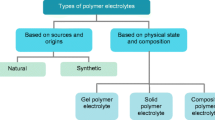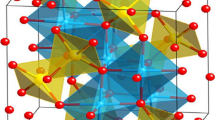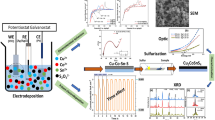Abstract
The sol-gel synthesis route, in combination with dip-coating deposition, was used for the preparation of FeVO4 films. TEM measurements of Fe/V (1 : 1)-oxide films heated at 400°C reveal that the films consist of a triclinic FeVO4-I and an orthorhombic FeVO4-II phases with a grain size of up to 50 nm. The electrochromic properties of the films were tested in 1 M LiClO4/propylene carbonate (PC) using various electrochemical techniques and in-situ UV-visible spectroelectrochemical measurements. The best compromise between the charge capacity per film thickness (Qd−1 = −0.14 mC cm−2 nm−1), electrochemical stability (>1000 cycles) and optical modulation (ΔTvis = 0.15) was achieved in the potential range of 4.80 to 1.80 V vs. Li, which suggests that FeVO4 films can be used as counter-electrodes in electrochromic devices.
Extensive IR-spectroscopy studies of FeVO4 films in charged/discharged states revealed the following spectra changes: (i) small charging (−0.01 mC cm−2 nm−1) leads to a variation in the intensity of all the vibrational bands without shifting their frequencies, (ii) higher chargings bring about the intensity and frequency changes of bridging V—O···Fe and V···O···Fe stretchings showing that vanadium, and probably also iron, are involved in the insertion/extraction processes, (iii) below 500 cm−1 broad absorption appears due to the Li+—O modes, which also remained in the IR spectra of discharged (bleached) states revealing the irreversible lithiation, and (iv) charging to −0.30 and −0.50 mC cm−2 nm−1 leads to the amorphisation of the film structure.
Similar content being viewed by others
References
B. Robertson and E. Kostiner, J. Solid State Chem. 4, 29 (1972).
Y. Oka, T.Yao, N.Yamamoto, Y. Ueda, S. Kawasaki, M. Azuma, and M. Takano, J. Solid State Chem. 123, 54 (1996).
J. Muller and J.C. Jaubert, J. Solid State Chem. 14, 8 (1975).
F. Laves, Acta Crystallogr. 17, 1476 (1964).
M. Misono, Catal. Rev. Sci. Eng. 29, 269 (1987).
L.M. Levison and B.M. Wanklyn, J. Solid State Chem. 3, 131 (1971).
S. Denis, E. Baudrin, M. Touboul, and J.M. Tarascon, J. Electrochem. Soc. 44, 4099 (1997).
Y. Sakurai and J. Yamaki, J. Electrochem. Soc. 132, 512 (1985).
M. Sugawara, M. Fujiwara, and K. Matsuki, Denki Kagaku 61, 224 (1993).
M. Touboul and A. Popot, Rev. Chim. Miner. 22, 610 (1985).
M. Touboul and A. Popot, J. Thermal. Anal. 31, 117 (1986).
E. Baudrin, S. Denis, F. Orsini, L. Seguin, M. Touboul, and J. M. Tarascon, J. Mater. Chem. 9, 101 (1999).
S. Ben?i?, B. Orel, A. Šurca, and U. Lavren?i? Štangar, Sol. Energy 68, 499 (2000).
C.G. Cranqvist, Handbook of Inorganic Electrochromic Materials, (Elsevier Amsterdam, 1995), p. 431.
F.W. Billmeyer and M. Saltyman, Principles of Colour Technology, (John Wiley &;; Sons, New York, 1981), p. 47.
A. Talledo and C.G. Granqvist, J. Appl. Phys. 77, 4655 (1995).
A. Šurca, B. Orel, G. Draži?, and B. Pihlar, J. Electrochem. Soc. 146, 232 (1999).
A. Šurca and B. Orel, Electrochem. Acta 44, 3051 (1999).
A. Šurca, B. Orel, U. Opara Kras?vec, U. Lavren?i? Štangar, and G. Draži?, J. Electrochem. Soc. 147, 2358 (2000).
U. Opara Krašovec, B. Orel, and R. Reisfeld, Electrochem. Solid State Lett. 1, 104 (1998).
U. Opara Krašovec, B. Orel, A. Šurca, N. Bukovec, and R. Reisfeld, Solid State Ionics 118, 195 (1999).
G. Picardi, F. Varsano, F. Decker, U. Opara Krašovec, A. Šurca, and B. Orel, Electrochim. Acta 18, 3157 (1999).
E.J. Baran and I.L. Botto, Monatshefte für Chemie 108, 311 (1977).
M.J. Isasi, R. Sáez-Puche, M.L. Veiga, L. Pico, and A. Jerez, Mat. Res. Bull. 23, 599 (1988).
E.J. Baran and M.E. Escobar, Spectrochim. Acta 41A, 415 (1985).
S. Hayakawa, T. Yoko, and S. Sakka, J. Non-Cryst. Solids 183, 73 (1995).
A. Müller, E.J. Baran, and P.J. Hendra, Spectrochim. Acta 41A, 415 (1985).
P. Tarte, Spectrochim. Acta 20, 238 (1964).
Y. Hase and I.V.P. Yoshida, Spectrochim. Acta A35, 377 (1979).
G. Fabbri and P. Baraldi, Anal. Chem. 44, 1325 (1972).
J. Issidorson and C.G. Granqvist, Sol. Energy Mat. Sol. Cells. 44, 375 (1996).
Angela Šurca, Sandra Ben?i?, Boris Orel, and Franco Decker, Sol-Gel Science and Technology, submitted.
R. Jasinski and A. Iob, J. Electrochem. Soc. 135, 551 (1988).
Author information
Authors and Affiliations
Rights and permissions
About this article
Cite this article
Vuk, A.Š., Orel, B., Dražič, G. et al. UV-Visible and IR Spectroelectrochemical Studies of FeVO4 Sol-Gel Films for Electrochromic Applications. Journal of Sol-Gel Science and Technology 23, 165–181 (2002). https://doi.org/10.1023/A:1013755618889
Issue Date:
DOI: https://doi.org/10.1023/A:1013755618889




